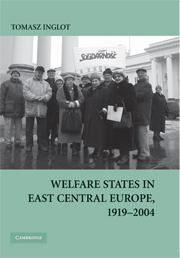Book contents
- Frontmatter
- Contents
- Figures and Tables
- Acknowledgments
- Welfare States in East Central Europe, 1919–2004
- Introduction: Understanding Past and Present Social Policy Development in East Central Europe
- 1 The Welfare State in East Central Europe: A Conceptual and Theoretical Reconsideration
- 2 Institutional Legacies: State Building, Regime Change, and the Development of National Welfare States in Czechoslovakia, Poland, and Hungary, 1919–1989
- 3 Policy Legacies and Welfare States under Communism: Cycles of Social Policy Expansion and Retrenchment in Czechoslovakia, Poland, and Hungary, 1945–1989
- 4 Historical Legacies, Welfare State Institutions, and the Politics of Social Policy Reforms in Postcommunist East Central Europe, 1989–2004
- Conclusion: Postcommunist “Emergency” Welfare States and Theoretical Exploration of Institutional Change and Social Policy Development
- Bibliography
- Index
Conclusion: Postcommunist “Emergency” Welfare States and Theoretical Exploration of Institutional Change and Social Policy Development
Published online by Cambridge University Press: 25 July 2009
- Frontmatter
- Contents
- Figures and Tables
- Acknowledgments
- Welfare States in East Central Europe, 1919–2004
- Introduction: Understanding Past and Present Social Policy Development in East Central Europe
- 1 The Welfare State in East Central Europe: A Conceptual and Theoretical Reconsideration
- 2 Institutional Legacies: State Building, Regime Change, and the Development of National Welfare States in Czechoslovakia, Poland, and Hungary, 1919–1989
- 3 Policy Legacies and Welfare States under Communism: Cycles of Social Policy Expansion and Retrenchment in Czechoslovakia, Poland, and Hungary, 1945–1989
- 4 Historical Legacies, Welfare State Institutions, and the Politics of Social Policy Reforms in Postcommunist East Central Europe, 1989–2004
- Conclusion: Postcommunist “Emergency” Welfare States and Theoretical Exploration of Institutional Change and Social Policy Development
- Bibliography
- Index
Summary
Historical examination of the origins, adaptation, and survival of the modern welfare states in Eastern and Central Europe reveals an intricate web of connections between the processes of political change and socioeconomic transformation, on one hand, and particular developmental trajectories of social policy in individual countries, on the other. This book sheds more light on these complex links and also opens up new avenues for future theoretical exploration. More specifically, it engages two broader arguments concerning the role of historical legacies in this region, one claiming that the so-called communist subtypes, which emerged in the Soviet bloc after 1945, in many ways reflect “the level of social and bureaucratic modernization in the interwar period” (Kopstein 2003, 238), and another one asserting that diverging legacies of Leninism and state socialism determine the outcomes of postcommunist transformations in significant ways (Grzymała-Busse 2002; Ekiert and Hanson 2003b; Seleny 2006).
As we have seen, the meaning and the causal impact of historical legacies on East Central European social policies, in particular, can be traced all the way back to the beginning of independent statehood and nationhood, and also to the alternating cycles of crises and attempted reform under communist rule during 1945–1989. Temporal evolution of the East Central European welfare states, before and after 1989, takes place simultaneously on three levels: structural, institutional, and policy (see Ekiert and Hanson 2003b).
- Type
- Chapter
- Information
- Welfare States in East Central Europe, 1919–2004 , pp. 306 - 314Publisher: Cambridge University PressPrint publication year: 2008



